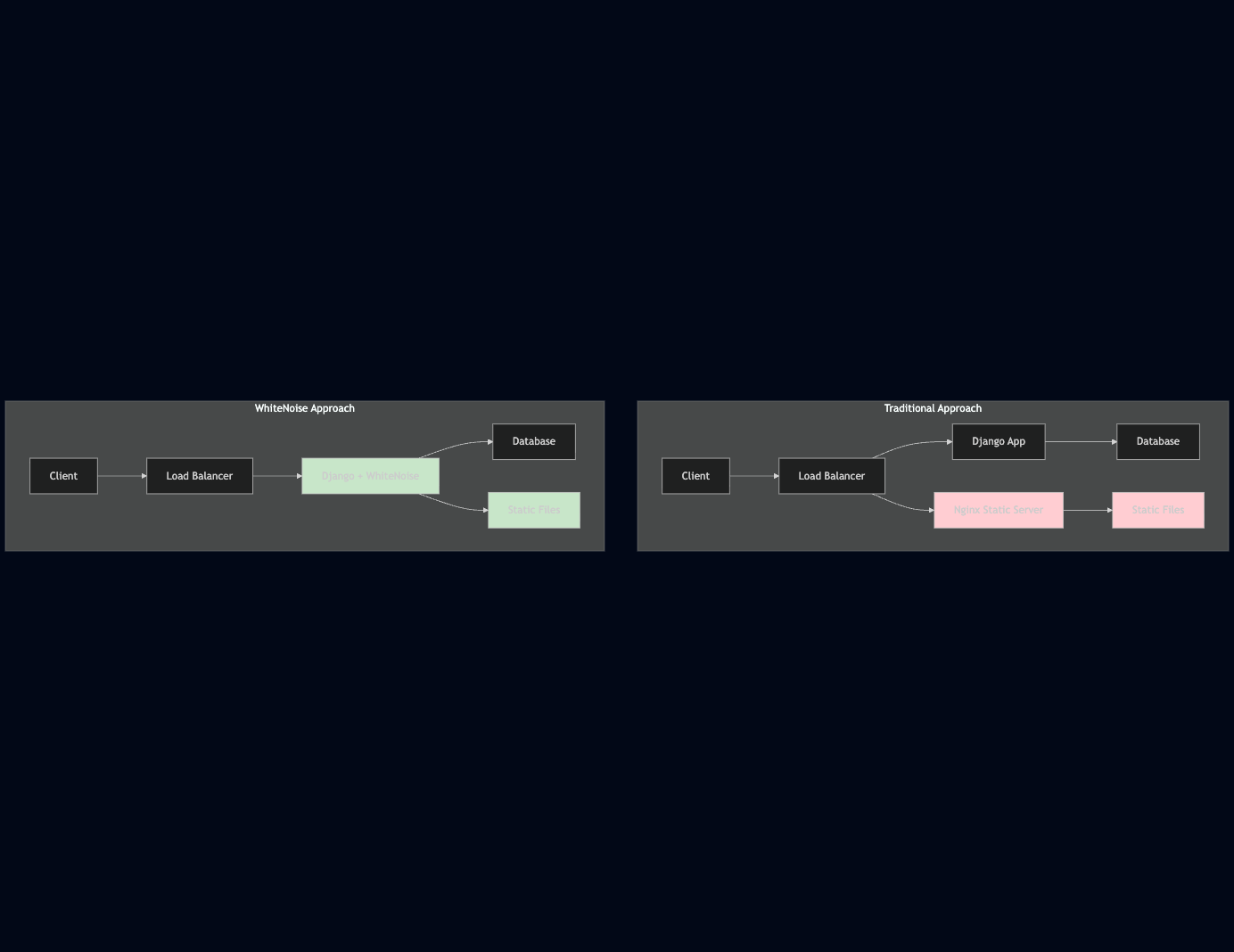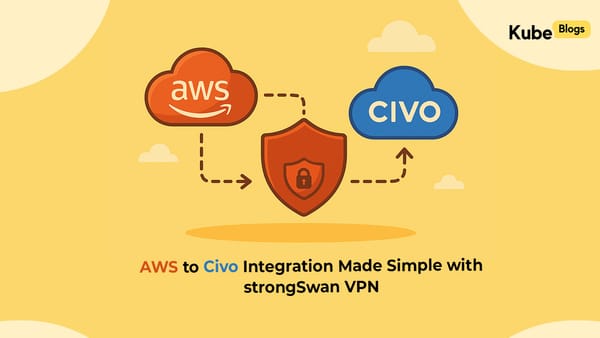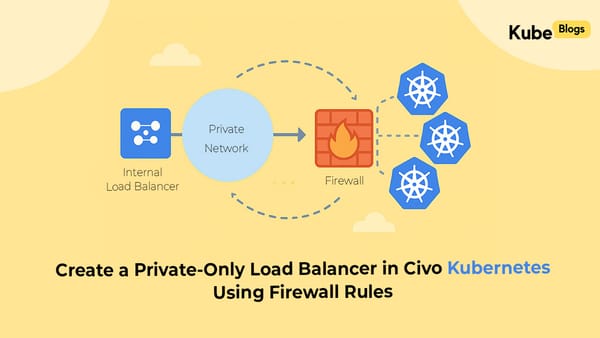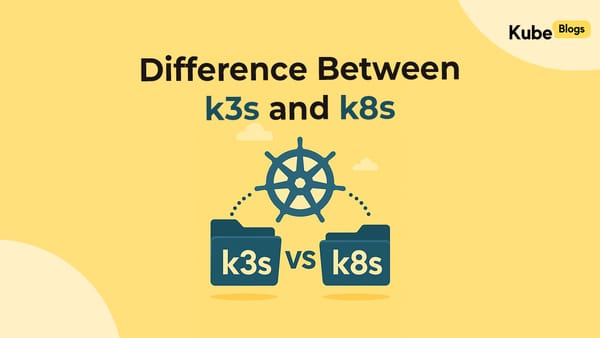Table of Contents
Introduction
Static file handling in Django production environments can be complex. When you deploy a Django application, you need to serve CSS, JavaScript, images, and other static assets efficiently. While Django's built-in static file handling works for development, it's not suitable for production due to performance and scalability limitations.
WhiteNoise solves this problem by providing a lightweight, high-performance solution for serving static files directly from your Django application. It eliminates the need for a separate web server like Nginx just for static files, making your deployment simpler and more cost-effective.
In this guide, we'll explore how to implement WhiteNoise in your Django project, using practical examples that you can adapt to your own projects. We'll cover everything from basic setup to advanced optimization techniques.

What is WhiteNoise?
WhiteNoise is a Django application that allows your Django app to serve its own static files. It's designed to be simple, fast, and production-ready. Unlike traditional approaches that require a separate web server, WhiteNoise integrates directly with your Django application.
Key features include:
- Automatic compression and caching of static files
- Support for long-term caching with unique filenames
- Gzip compression for better performance
- Automatic handling of file types and MIME types
- Integration with Django's static file collection system
Why Use WhiteNoise in Production?
Traditional static file serving approaches have several drawbacks:
- Complexity: Requires configuring and maintaining a separate web server
- Cost: Additional infrastructure and configuration overhead
- Performance: Extra network hops between your app and static file server
- Scalability: Static file server becomes a potential bottleneck.

WhiteNoise addresses these issues by:
- Simplifying your deployment architecture
- Reducing infrastructure costs
- Improving performance through direct serving
- Making your application more self-contained
Step-by-Step Implementation
1. Install WhiteNoise
First, add WhiteNoise to your project dependencies:
pip install whitenoiseOr add it to your requirements.txt:
whitenoise==6.6.02. Configure Django Settings
In your Django settings, you need to add WhiteNoise to your middleware and configure static file handling. Here's a practical implementation example:
# settings/base.py
MIDDLEWARE = [
# ... other middleware
"whitenoise.middleware.WhiteNoiseMiddleware",
# ... rest of middleware
]
# Static files configuration
STATIC_URL = "/static/"
STATIC_ROOT = BASE_DIR / "staticfiles"
# WhiteNoise configuration
STORAGES = {
"default": {
"BACKEND": "guardnine.utils.storages.MediaRootS3Boto3Storage",
},
"staticfiles": {
"BACKEND": "whitenoise.storage.CompressedManifestStaticFilesStorage",
},
}3. Configure WhiteNoise Settings
Add these WhiteNoise-specific settings to optimize performance:
# WhiteNoise configuration
WHITENOISE_USE_FINDERS = True
WHITENOISE_AUTOREFRESH = True
WHITENOISE_MAX_AGE = 31536000 # 1 year in seconds
# For development
if DEBUG:
WHITENOISE_AUTOREFRESH = True
else:
WHITENOISE_AUTOREFRESH = False4. Update Your Base Template
Ensure your base template includes the static files tag:
{% load static %}
<!DOCTYPE html>
<html>
<head>
<link rel="stylesheet" href="{% static 'css/style.css' %}">
</head>
<body>
<!-- Your content -->
<script src="{% static 'js/app.js' %}"></script>
</body>
</html>5. Collect Static Files
Before deployment, collect all static files:
python manage.py collectstaticThis command will gather all static files from your apps and place them in the STATIC_ROOT directory.
Advanced Configuration Options
Compressed Manifest Storage
The CompressedManifestStaticFilesStorage backend provides automatic file compression, unique filenames for long-term caching, and manifest file support for version control.
Environment-Specific Configuration
Good Django projects show separation of concerns with environment-specific settings. In production, you'll want to disable auto-refresh and file finders for optimal performance.
Performance Optimization
1. Caching Strategy
WhiteNoise automatically handles caching through unique filenames. When you run collectstatic, it creates a manifest file that maps original filenames to hashed versions for long-term caching.
2. Compression
Enable Gzip compression for better performance by configuring WhiteNoise to use compressed storage backends.
3. CDN Integration
For global applications, combine WhiteNoise with a CDN by updating your STATIC_URL settings.
Security Considerations
1. File Type Restrictions
WhiteNoise automatically sets appropriate MIME types and security headers. However, you should:
- Validate file uploads
- Use HTTPS in production
- Set appropriate Content Security Policy headers
2. Access Control
Ensure static files don't contain sensitive information by disabling directory listings.
3. Security Headers
Add appropriate security headers in your production settings to protect against common web vulnerabilities.
Monitoring and Troubleshooting
1. Performance Monitoring
Monitor static file serving performance by configuring appropriate logging levels for WhiteNoise.
2. Common Issues
Static files not loading:Check that collectstatic the run was done and STATIC_ROOT is correct.
404 errors: Verify WhiteNoise middleware is in the correct order.MIDDLEWARE
Performance issues: Ensure file finders are disabled in production.
3. Debugging
Enable debug mode for WhiteNoise in development to help troubleshoot configuration issues.
Conclusion
WhiteNoise provides a robust, production-ready solution for serving static files in Django applications. By integrating it into your Django project, you create a scalable foundation that eliminates the complexity of managing separate static file servers.
The key benefits of this approach include:
- Simplified deployment architecture
- Improved performance through direct serving
- Automatic compression and caching
- Reduced infrastructure costs
- Better developer experience
Using CompressedManifestStaticFilesStorage shows enterprise-grade thinking, providing both performance optimization and long-term caching capabilities. This setup is particularly valuable for teams that need to deploy Django applications quickly while maintaining production-quality performance.
For teams looking to implement this pattern, start with the basic configuration and gradually add advanced features like custom storage backends and CDN integration as your needs grow. The modular approach makes it easy to adapt these settings for different environments and requirements.
Remember that static file serving is just one part of a production Django deployment. Combine WhiteNoise with proper database optimization, caching strategies, and monitoring to create a truly robust application infrastructure.






